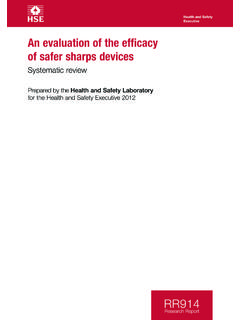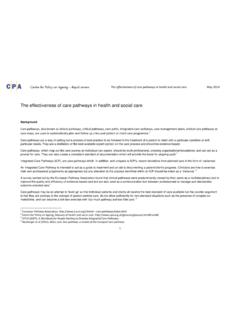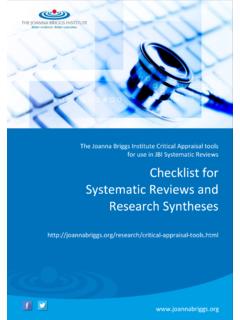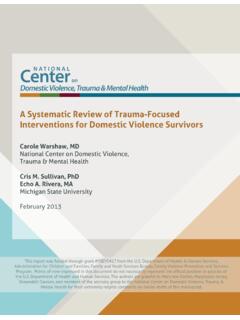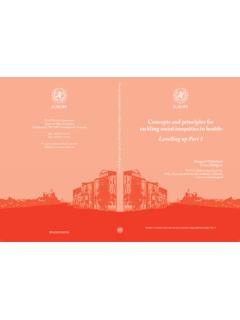Transcription of What are the advantages and limitations of different ...
1 What are the advantages and limitations of different quality and safety tools for health care ? October 2005 2 ABSTRACT This is a health Evidence Network (HEN) synthesis report on the advantages and limitations of different quality and safety tools for health care . The term quality tools includes many safety and quality methods, frameworks, programmes or systems. Some are diagnostic methods to help decision-making, some are for intervention and change only, and some include both methods for diagnosis and intervention. The main recommendations from this synthesis of the literature are based on a few studies which give weak evidence, and on a critical assessment of the descriptive research and practitioner report literature: 1) Simple continuous quality improvement (CQI) tools are useful for more effective everyday problem-solving, not just for quality improvement. 2) There is some evidence that guidelines, patient pathway methods, quality costing and statistical process control are effective in health care , when properly applied.
2 HEN, initiated and coordinated by the WHO Regional Office for Europe, is an information service for public health and health care decision-makers in the WHO European Region. Other interested parties might also benefit from HEN. This HEN evidence report is a commissioned work and the contents are the responsibility of the authors. They do not necessarily reflect the official policies of WHO/Europe. The reports were subjected to international review, managed by the HEN team. When referencing this report, please use the following attribution: vretveit J (2005). What are the advantages and limitations of different quality and safety tools for health care ? Copenhagen, WHO Regional Office for Europe ( health Evidence Network report; , accessed [day month year]). Keywords QUALITY INDICATORS, health care SAFETY MANAGEMENT methods COMPARATIVE STUDY DELIVERY OF health care META-ANALYSIS DECISION SUPPORT TECHNIQUES EUROPE Address requests about publications of the WHO Regional Office to: by e-mail (for copies of publications) (for permission to reproduce them) (for permission to translate them) by post Publications WHO Regional Office for Europe Scherfigsvej 8 DK-2100 Copenhagen , Denmark World health Organization 2005 All rights reserved.
3 The Regional Office for Europe of the World health Organization welcomes requests for permission to reproduce or translate its publications, in part or in full. The designations employed and the presentation of the material in this publication do not imply the expression of any opinion whatsoever on the part of the World health Organization concerning the legal status of any country, territory, city or area or of its authorities, or concerning the delimitation of its frontiers or boundaries. Where the designation country or area appears in the headings of tables, it covers countries, territories, cities, or areas. Dotted lines on maps represent approximate border lines for which there may not yet be full agreement. The mention of specific companies or of certain manufacturers products does not imply that they are endorsed or recommended by the World health Organization in preference to others of a similar nature that are not mentioned.
4 Errors and omissions excepted, the names of proprietary products are distinguished by initial capital letters. The World health Organization does not warrant that the information contained in this publication is complete and correct and shall not be liable for any damages incurred as a result of its use. The views expressed by authors or editors do not necessarily represent the decisions or the stated policy of the World health Organization. What are the advantages and limitations of different quality and safety tools for health care ? WHO Regional Office for Europe s health Evidence Network (HEN) October 2005 3 Summary .. 4 The 4 Findings .. 4 Policy 4 Type of evidence .. 5 Introduction .. 6 Methods and sources for this 6 Findings .. 7 What is a quality tool ? .. 7 Most often used quality and safety tools in health care .. 7 What is the research evidence about each tool? .. 8 Conditions for effective tool use .. 13 Discussion .. 14 Gaps in evidence and conflicting evidence.
5 14 Current debate in this field ..15 Conclusions .. 15 Table 1: Summary of quality and safety 16 Annex 1: Sources and methods for review and synthesis .. 18 References .. 19 What are the advantages and limitations of different quality and safety tools for health care ? WHO Regional Office for Europe s health Evidence Network (HEN) October 2005 4 Summary The issue The term quality tools is used in many different ways to refer to a method used by an individual, a team, an organization or a health system. It is most often used in a narrow sense in American texts to refer to a set of simple continuous quality improvement methods (CQI tools). More broadly, it includes many other safety and quality methods, frameworks, programmes or systems. Some are diagnostic methods to help decision-making, some are for intervention and change only, and some include both methods for diagnosis and intervention. Findings The simple tools most often reported to be used in continuous quality improvement include brainstorming, cause and effect diagrams, nominal group and Delphi technique, flow charts, histograms, control charts, Pareto diagrams, run charts, scatter diagrams, checklists, tables, and counts.
6 Less often reported are the more complex tools: statistical process control (SPC), quality function deployment (QFD), and design of experiments study (DOE). These and other tools are also reported to be used within quality assurance or audit frameworks. The most commonly used systematic approaches are the continuous quality improvement plan-do-check-act (CQI PDCA) cycle, the Langley model, the team quality improvement sequence (TQIS), and different versions of the audit cycle and of patient pathway frameworks. There is no clear evidence about which of the CQI, quality assurance or audit frameworks are most effective, but there is evidence that systematic and persistent use of a framework is necessary for results. There is evidence that statistical process control and quality costing methods are effective, but that the time and skills necessary to use them properly are greater than for many other tools. Both are disadvantaged in health care by the lack of quality data. There are different views about whether guideline development and implementation is a quality tool , but it is probably the most closely studied and most common method used in health care to make quality and safety improvements.
7 Guidelines are used in CQI projects as a method of implementing a change to practice. They are most often used as a way to convert research evidence into practical rules to follow in a local setting. Other multi-method tools include benchmarking, reengineering, and patient pathway methods. There is evidence of positive results for all, although there are mixed results, higher costs and methodological questions regarding reengineering. The EFQM (European Foundation for Quality Management) organizational assessment method, some types of clinical audit and some structured peer review methods show weak evidence of positive results. The most often used safety tools in health care are incident report data collection and analysis and root cause analysis methods. Other safety tools which could be used in health care are behavioural observation, crew resource management failure mode and effect analysis, and human factors engineering design methods. No studies were found that examined whether tools were used properly, or interventions to increase their effectiveness.
8 Policy considerations The main recommendations from this synthesis of the literature are based on a few studies which give weak evidence, and on a critical assessment of the descriptive research and practitioner report literature: 1) Simple continuous quality improvement (CQI) tools are useful for more effective everyday problem-solving, not just for quality improvement. All health personnel should at least know what the simple CQI tools are, and should use reports and simple costing methods to assess whether to use a tool. What are the advantages and limitations of different quality and safety tools for health care ? WHO Regional Office for Europe s health Evidence Network (HEN) October 2005 5 2) There is some evidence that guidelines, patient pathway methods, quality costing and statistical process control are effective in health care , when properly applied. More use should be made of these methods. However, the latter requires more training and guidance than other methods. Type of evidence Review of systematic reviews and critical assessment of descriptive research and other reports.
9 The author of this synthesis is: Dr John vretveit Professor of health Policy and Management Bergen University Faculty of Medicine, Norway and The Nordic School of Public health , Gothenburg, Sweden. E-mail: The technical editor of this synthesis is: Professor Egon Jonsson, health Evidence Network What are the advantages and limitations of different quality and safety tools for health care ? WHO Regional Office for Europe s health Evidence Network (HEN) October 2005 6 Introduction A systematic and fact-based approach to quality lies at the centre of the industrial quality and safety movement applied in health care in the last 20 years. A number of tools (or methods) are commonly used to carry out this approach. Some quality and safety tools have been developed and used separately, but are now being brought together within health care , and within specific projects. Hence this synthesis covers both sets of tools, referred to collectively as quality tools . Some are simple tools such as brainstorming, some are multiple-method tools such as re-engineering and some are frameworks such as the plan-do-check-act (PDCA) and audit cycles.
10 The tools are summarized in Table 1. There is debate about the effectiveness, feasibility and costs of each of these tools in health care , and how much time health care professionals should spend learning and using them. Those using the tools also want to know when to use each and which is most effective in which conditions. What is the evidence from research about the benefits and limitations of each in a hospital or community setting? Have they been used and how? How easy and costly were they to use? What were the results? This synthesis gathered and presents different types of evidence to answer these questions and aims to: note the different tools reported to have been used in health care ; give references to the best descriptions of them; and present evidence about the tools, such as effectiveness reported in scientific research, or experience reported in an observational study, survey or project report. The synthesis does not consider the use of tools together in a quality programme: this is reported in a complementary HEN report on quality strategies for hospitals (1).










